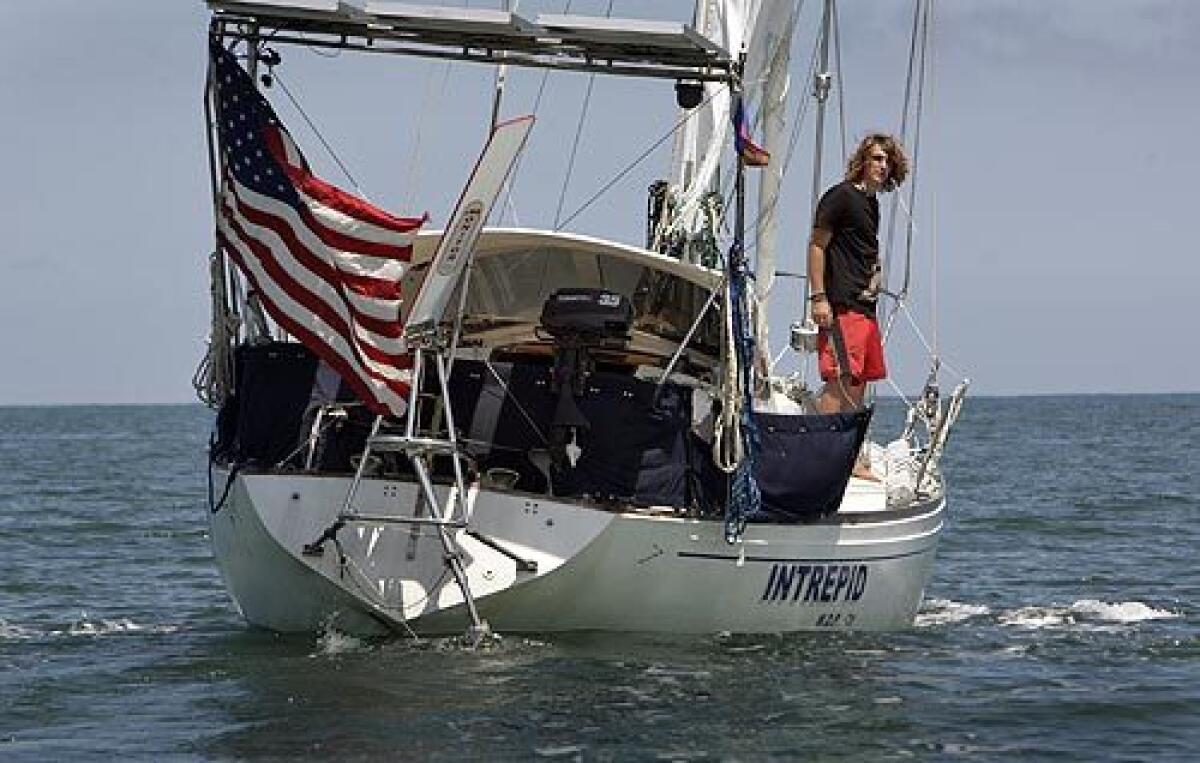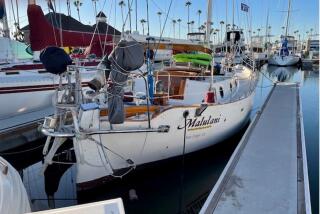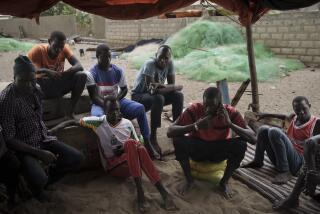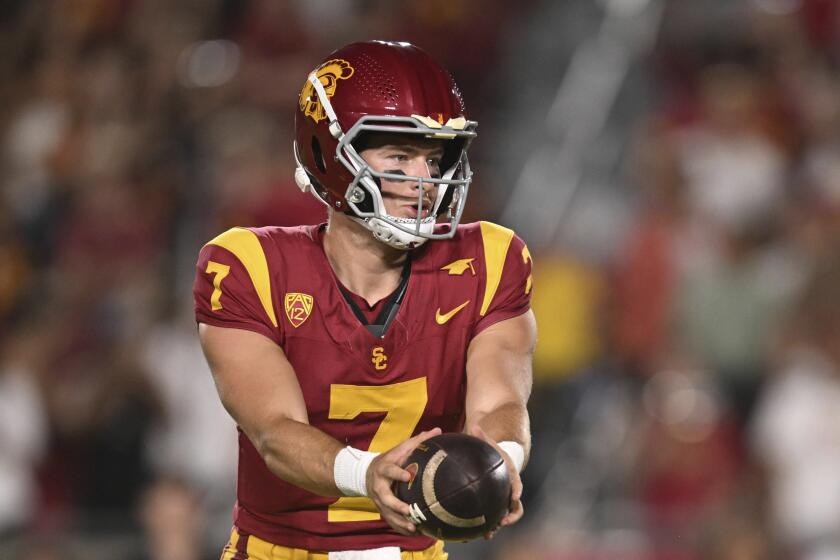Southland teen nears the finish of his global sea odyssey

>>video >>
Zac Sunderland is wedged in his small bunk, reading, as his 36-foot sailboat ascends and careens down mountainous, shifting peaks.
Just ahead on this late June morning is Mexico’s first seasonal tropical depression, whose winds have roiled the Pacific. To the south, churning up the coast: a larger storm building into a hurricane.
Sunderland, 17, is more than 100 miles offshore on the final leg of a 13-month, around-the-world odyssey. He holds course but is interrupted by a jarring thud and what sounds like a gunshot.
FOR THE RECORD:
Sailor: A front-page article Monday about teenager Zac Sunderland’s bid to solo-circumnavigate the globe in a sailboat referred to one of his stops as the Cokos Keeling Islands. The correct spelling of the Indian Ocean islands is Cocos Keeling. The article also said Sunderland is a student at Grace Brethren High School in Thousand Oaks. The school is in Simi Valley. —
His boat, Intrepid, has launched from a 10-foot wave and its port-side bulkhead has buckled on impact. The deck flexes and chain plates with lines supporting the mast have ripped loose. Wind hisses loudly, menacingly.
He must change course and try to reach the nearest refuge, Puerto Vallarta.
Sunderland has grown accustomed to adversity since he embarked from Marina del Rey on June 14, 2008, on a mission to become the youngest sailor ever to circumnavigate the globe alone. He was 16 and didn’t even have a driver’s license.
The idea had been in his mind since he read “The Dove” as a child. The book chronicles a five-year circumnavigation by Robin Lee Graham, whose voyage ended in 1970, when he was 20.
Sunderland, a shipwright’s son and an experienced sailor, planned the journey himself. He would cross the Pacific and Indian oceans before rounding Africa’s Cape of Good Hope, then cross the Atlantic, pass through the Panama Canal and sail north along the Central American and Mexican coasts before returning home.
He would subsist on freeze-dried and canned food when fresh provisions ran out, and he would desalinate his drinking water with an on-board kit.
What Sunderland, due to return to Marina del Rey about July 14, could not foresee were the dangers and difficulties.
Notable was the pirate scare. In October, he was 150 miles beyond Indonesia, on a course from Australia to the Cokos Keeling Islands, when he encountered a mysterious boat. The 60-foot wooden vessel did not appear on his radar screen.He tried unsuccessfully to raise its crew on the radio. He changed direction; it changed direction.
Winds were light and he could not escape, so he clutched his satellite phone -- his lifeline -- and dialed his home in Thousand Oaks.
A sister answered. Laurence Sunderland heard his son’s panicked voice, grabbed the phone and rushed into his office. Zac’s heart raced as he digested the instructions: Load your pistol and flare gun, then issue a radio security alert with your position.
Fire a warning shot if necessary, but at the first sign of aggression, shoot to kill because they’ll try to kill you.
Laurence recalls: “For two hours we’re sitting here not knowing what the situation was or whether Zac could handle it.”
The decrepit craft swept directly into Intrepid’s wake, its crew still hidden, as Sunderland placed his emergency call. Then it motored away.
“For 30 minutes I was living on the edge out there, not knowing what to do,” he says.
Yet this was not the most harrowing experience for a long-haired adventurer who rarely expresses emotion while recounting his adventure.
“The whole trip was scary,” he says, almost dismissively, during an interview last week in Puerto Vallarta, where he had stopped for repairs. “Broken forestay . . . broken boom . . . broken tiller . . . the rogue wave off Grenada that broke over the back of the boat at 2 a.m. and took out all the electronics. . . . “
Laurence can vividly recall “four specific times that we’ve been put to our knees in prayer.”
One involved his son’s passage through the treacherous Torres Strait between Australia’s Cape York Peninsula and Papua New Guinea in early September. The passage boasts a vast maze of reefs and requires constant vigilance to negotiate.
But there was casual Zac, reeling in a fish, when the satellite phone slid into the cabin sink and delivered a false signal relaying his position as 100 miles off-course, on a dry reef.
Laurence and his wife, Marianne, tried frantically for 20 hours to reach their son and verify his position. They had begun to request a search-and-rescue mission from Australia when, about midnight in California, a message relayed via high-frequency radio appeared on their computer screen:
“Hi mom, I’m OK.”
Even more intense, for Zac, was an ordeal hundreds of miles into the Indian Ocean in November. Windswept waters had reached 15 feet and gale-force gusts blasted Intrepid.
The forestay rigging, which holds the forward sail and helps secure the mast, tore loose and the drum used to furl the sail banged errantly, smashing parts of the bow and threatening to bash a hole in the boat.
The forestay also supports the mast, so Intrepid was at extreme risk. With the drum loose, Sunderland could only partially furl the forestay’s Genoa sail, which whipped violently in the wind, tearing at lines. He worked feverishly through two days and nights atop a slippery deck and secured the situation as best he could.
Then he collapsed and awoke later to discover that the storm had cleared.
Laurence had flown to Mauritius to greet his son with spare parts for Intrepid. When the boat hobbled into port, he recalls, “it looked like a dog that had been in a fight and had come up second-best.”
Of Zac, his father says: “He looked drawn and worn-out, relieved to see a familiar face.”
The fourth incident occurred before Sunderland crossed the Panama Canal into the Pacific in early May. Freighters were lining up for passage appointments and Intrepid was a speck amid steel-hulled giants. One freighter ran without navigation lights and the sailor could not determine which direction it was traveling.
He spent all night trying to avoid colliding with or being swamped by the 300-foot vessel. At one point before dawn, the frustrated mariner shone his spotlight at the freighter’s deck and issued a prolonged, one-fingered salute.
Then he threw up over the side. It was the closest he’d come to losing the boat.
Sunderland’s journey has not been one long nightmare. There were exhilarating times at sea when he and Intrepid galloped swiftly like man and horse.
He received a colorful native greeting at Majuro in the Marshall Islands, his second stop after Hawaii, and along the way he met fellow cruisers and remained in contact with them there and beyond.
He was welcomed with tremendous hospitality in almost every port, testament to the tight-knit nature of the global sailing community.
But he also witnessed poverty and civil unrest. After Majuro, he sailed 2,380 miles to Port Moresby in Papua New Guinea. It’s among the world’s most dangerous cities. Sunderland describes the yacht club as an armed fortress for the wealthy few and shakes his head while recalling how he was escorted to the market by two guards wearing bulletproof vests and toting AK-47s.
“There was a war going on and people were getting shot in the streets,” he says. “But they didn’t give me a bulletproof vest.”
Zac enjoyed the Cocos Keeling Islands in the Indian Ocean, halfway between Australia and Sri Lanka, and he loved his three-week stay in Cape Town, South Africa.
His “Zac Pack” fan base grew as he put miles beneath his keel, but the wisdom and judgment of his parents were debated on Internet comment boards.
“It’s not negligence,” says Marianne, a mother of seven, who points to her eldest son’s extensive sailing background and adventurous spirit. “It’s just that we’re not accustomed to living inside the box. We pay our taxes and do things legally, but what’s the harm in letting a kid pursue his dream?”
Sunderland set sail after his sophomore year at Grace Brethren High School in Thousand Oaks, intent on breaking a record held by Australia’s David Dicks, who completed his circumnavigation when he was 18 years and 41 days old.
Sunderland turned 17 on Nov. 29 in the Indian Ocean. He celebrated with a just-add-water microwaveable cake. It was a lonely experience, but he was becoming worldly beyond his years.
However, a middle-class American teenager matures only so fast. During an extended stay for repairs on St. Helena, a flyspeck in the South Atlantic about midway between Africa and South America, he became cranky and complained on his Facebook page that he was “stranded on a deserted island.”
Irked by his attitude, his mother vented publicly on his blog: “There are times when he seems far older than his years and others that just make you scratch your head and wonder if this is the same kid who just sailed halfway around the world.”
The adventure has taxed his parents. Laurence has tried to keep to a work schedule but has routinely flown off to tend to Zac’s injured vessel. Marianne, with a house full of home-schooled children, has been working full-time on logistics.
The trip has been partially funded by Clearpoint Weather, a provider of digital weather information for sailors and pilots; Bandacorp, which designed and maintains Zac’s website (zacsunderland.com); and Produce for Kids, a nonprofit that promotes healthy diets for children. Still, Laurence says the family has spent $150,000 and hopes to recoup some from the sale of a DVD that will feature footage from Zac’s journey.
But neither parent expresses regret. On the contrary, Laurence says, “this has meant something far bigger than words can express.
“I don’t think Marianne or myself have realized until now how much of us has been out there with him. But it’ll be a big day when he gets back and we’ll be very proud, because Zac will have achieved something that very few people will ever be able to achieve, and it has changed him and it’ll be with him the rest of his life.”
Zac sails into Puerto Vallarta’s vast Banderas Bay with a mast braced by his handiwork with halyards, just as Tropical Storm Andres is upgraded to a Category 1 hurricane.
The sea is jumbled, and driving rain and wind hamper visibility. David Ramirez, aboard a skiff from Paradise Village Marina, arrives to guide Sunderland to dock.
The sailor disembarks looking disheveled and with squinty eyes, but that’s been his look at almost every stop: as if he just woke up after a late night out with friends.
A day later, during an interview, he talks about a recent string of setbacks along the Mexican coast -- he had most recently ducked into Manzanillo to dodge the tropical depression.
But he does not complain about the storms or the previous two weeks, spent in a windless swelter, where the ocean and air and the water he drank were 90-plus degrees.
Instead, he talks about grabbing his surfboard and tackling the 25-foot waves breaking around the point. He offers a reporter his second board, then remembers it broke in two somewhere on the planet.
Laurence has begun rebuilding the bulkhead, while Zac explains that were it not for this misfortune, he might have continued on a northerly course and been swept up by Andres.
A day later, the storm has spun to the west and dissipated. Intrepid has a clear weather window, a new bulkhead, a scraped hull and tuned sails.
That late June evening Zac is underway, hoping to arrive home in two weeks. The boat is faintly visible from the north end of Banderas Bay. The pale white triangle looks like part of a painting, subtly contrasting with a dusk sky swathed in pink and orange.
Then it glides between two of the coal-colored Tres Marietas Islands, and it’s gone.
More to Read
Get our high school sports newsletter
Prep Rally is devoted to the SoCal high school sports experience, bringing you scores, stories and a behind-the-scenes look at what makes prep sports so popular.
You may occasionally receive promotional content from the Los Angeles Times.






